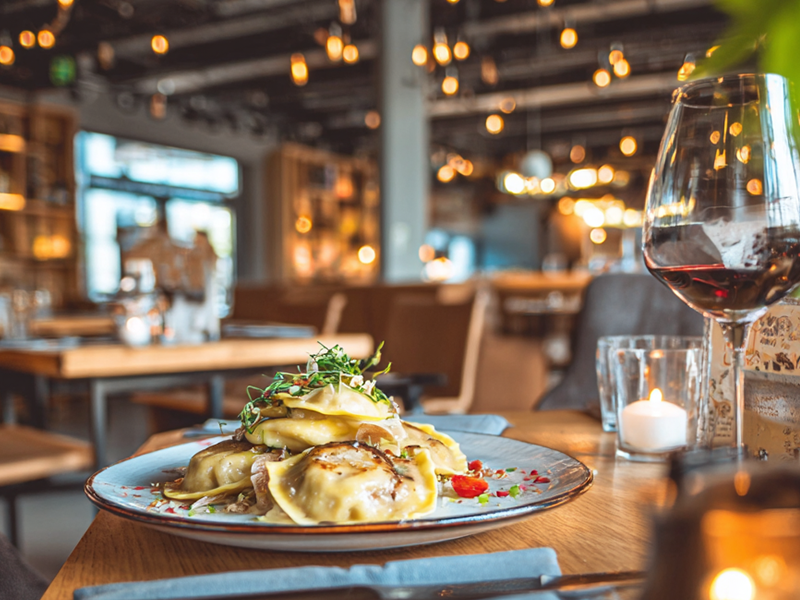By Katrin Krakovich, CEO of Lahav Media
I'll be honest with you: most restaurant owners approach Google reviews like they're asking customers for a kidney donation. They mumble something awkward about "leaving a review if you have time," then wonder why their Google Business Profile sits at a measly 3.2 stars with 12 reviews from 2019.
Meanwhile, the pizza place down the street somehow has 847 five-star reviews and a line out the door every Friday night.
Here's what I've learned after helping dozens of restaurants, cafes, and coffee shops build their review reputation: getting more local reviews isn't about begging or bribing. It's about creating systems that make leaving reviews feel natural, rewarding, and frankly, inevitable.
Why Google Reviews Actually Matter for Restaurants (Beyond the Obvious)
Before we dive into tactics, let's talk reality. Google reviews don't just influence where people eat dinner tonight. They're now feeding AI search results in ChatGPT, Google Gemini, and other platforms that potential customers use to find local restaurants.
When someone asks their AI assistant, "What's the best brunch spot near me?" guess what determines the answer? Your review count, star rating, and recent review activity all factor into those AI-generated recommendations.
Plus, Google's local search algorithm heavily weighs review signals. More reviews mean better visibility in Google Maps, which is where 76% of people discover new restaurants.

The "Desert Strategy" That Actually Works
Here's a tactic I've seen work beautifully at cafes and restaurants: the immediate gratification review incentive.
Instead of handing customers a business card with "Please review us on Google" (which ends up in the parking lot trash can), try this approach:
While they're still at the table, finishing their meal:
"Hey, I noticed you really enjoyed the salmon. Would you mind taking 30 seconds to leave us a quick Google review right now? If you do, I'll bring you a complimentary dessert to share."
Then you actually watch them do it. Not in a creepy way, but you stay nearby, help them find your Google Business Profile if needed, and once they hit "submit," you bring that free tiramisu or coffee shop cookie.
This works because:
- The experience is fresh in their mind
- They're already in a good mood (assuming the food was good)
- The reward is immediate
- You can ensure they actually complete the review
I've seen coffee shops increase their monthly reviews from 3 to 47 using variations of this approach.

The Right Way to Ask (Without Being That Restaurant)
Most restaurants ask for reviews like they're interrupting a funeral service. Here's how to make it feel natural:
Timing is everything. Don't ask when they're rushing out the door or when they're clearly having relationship drama over appetizers. Wait for that sweet spot when they're relaxed, satisfied, and genuinely seemed to enjoy themselves.
Make it specific. Instead of "Would you leave us a review?" try "I saw how much you loved the chorizo breakfast burrito. Would you mind sharing that experience in a quick Google review?"
Provide context. "We're a small family-owned cafe, and Google reviews really help other people in the neighborhood discover us."
Offer gentle assistance. "Need help finding us on Google? We're listed under [exact business name]."
Creating Review-Worthy Moments (The Secret Sauce)
The best restaurant review strategies don't just ask for reviews, they create experiences worth reviewing.
Think about what makes people naturally want to share. Usually, it's something unexpected, delightful, or above-and-beyond normal service.
Maybe it's the barista who remembers regulars' names and orders. The restaurant that brings out a free appetizer because the kitchen was running slow. The coffee shop that has genuinely good WiFi and doesn't make laptop users feel guilty for camping out.
These moments create what I call "review momentum" where customers actually want to tell others about their experience.
The Follow-Up System That Doesn't Feel Desperate
Not everyone will leave a review on the spot, and that's fine. But you need a follow-up system that doesn't make you sound like a telemarketer.
Email approach (24-48 hours later): "Thanks for visiting [Restaurant Name] yesterday! We hope you enjoyed the mushroom risotto. If you have a minute, we'd love to hear about your experience in a Google review."
Text message approach (for customers who opted in): "Hey [Name]! How was the latte art yesterday? 😊 Mind leaving us a quick review on Google? Here's the link: [direct link]"
Keep it short, personalize it based on what they ordered, and include a direct link to your Google review page.

Handling the Inevitable Bad Reviews
Let's be real: you will get negative reviews. Even restaurants with Michelin stars have one-star Google reviews from people complaining about parking or the hostess's attitude.
The key is responding quickly and professionally. Don't get defensive. Don't argue with the customer publicly. Address their specific concerns and invite them to discuss it privately.
"Hi Sarah, thanks for the feedback about the wait time. We had an unusually busy evening, but that's not an excuse for the delay. I'd love to make this right, please give me a call at [number]."
Sometimes the most impressive thing to potential customers isn't your five-star reviews, it's how you handle the two-star ones.
Review Request Tools That Don't Suck
If you're getting decent foot traffic, manually asking every customer becomes impossible. Here are some automation tools that actually work:
QR codes on receipts that link directly to your Google review page. Simple, non-pushy, and customers can choose whether or not to scan.
Table tents with review QR codes placed strategically (not blocking the salt, please).
Point-of-sale integration that sends review requests via email or text 24 hours after purchase (with customer consent).
The key is making the review process as frictionless as possible. Every extra click or step reduces completion rates by about 30%.
Measuring What Actually Matters
Most restaurant owners track review count, but that's like judging a book by how many pages it has.
Here's what actually impacts your local search visibility and customer decisions:
- Recent review velocity (reviews in the last 30 days)
- Average rating trend (improving vs. declining)
- Review response rate (how often you respond to reviews)
- Keyword mentions in reviews (specific dishes, experiences, atmosphere)
- Photo uploads with reviews (customers posting food photos)
Track these monthly and you'll spot trends before they become problems.
The Long Game: Building a Review Culture
The restaurants and cafes that dominate local search don't just collect reviews, they build review cultures.
This means training your entire staff to recognize review-worthy moments, empowering servers to offer small incentives, and creating systems where asking for reviews feels natural rather than scripted.
When your team genuinely believes in the experience you're providing, asking for reviews stops feeling like sales and starts feeling like sharing something good with the community.
And honestly? That's when the reviews start coming automatically.

-p-500.jpg)
